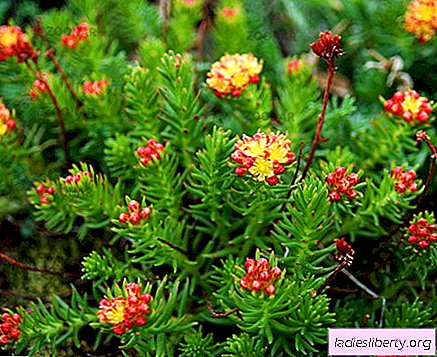
Red brush - general description
Red brush (another name is Rhodiola quadrifida rhodiola) - a low perennial dioecious herbaceous plant (up to 15 cm in height) of the family Crassulaceae, has a pillow-shaped shape. The root root is thick, elongated, capable of extracting water at great depths. Numerous erect densely leafy stems have a reddish hue.
The leaf is linear, lanceolate, in inflorescences on the top of the stem there is a small-flowered scutellum. The flowers are small, yellowish, reddened at the apex. The plant has brown oblong-shaped seeds. Young buds are protected by last year's leaf litter with small earth particles forming a decaying mass. The flowering time of the plant is the beginning and first half of summer.
Red brush - types and places of growth
The red brush is better known by its middle name and has several varieties of name - four-membered rhodiola, four-part rhodiola, four-cut rhodiola. This is the endemic of Altai, that is, a plant that is found only in the Altai mountains. The mountain lifestyle gave the red brush wonderful medicinal properties that are used in traditional medicine.
This plant is located in the regional Red Books of Mongolia, Yakutia and Buryatia, it is protected in the largest reserves of Siberia, such as Vitimsky and Baikal-Lensky. In the Alpine zone of Russia (in Altai, in the Sayan Mountains, in the Sikhote-Alin and the Uchur, Mai, Suluk river basin), it can be found on rocks, in rocky alpine meadows and in thickets along with cedar elfin. In the Eastern Sayan Mountains it grows very abundantly, in rare groups.
Red brush - healing properties
The red brush is a phenomenal plant, primarily helping with many female and male gynecological and urological diseases, sexual disorders. It helps men with weakening potency, oligospermia, male infertility and sexual coldness. Female diseases that can be treated with rhodiola are endometriosis, ovarian cyst, fibroids, fibromyoma, menopause, mastopathy, cervical erosion, amenorrhea, adnexitis. Rhodiola normalizes the menstrual cycle and eliminates various endocrine diseases.
The basis of the positive effect of the herb is salidroside glycoside, which activates oncoprotective, anti-inflammatory, anti-infectious and adaptogenic properties. In addition to gynecological diseases, the red brush is used for diseases of the kidneys and thyroid gland, adrenal dysfunction, cystitis. It can be used for epilepsy and leukemia, as well as anemia and diseases of the heart and blood vessels. It is a powerful anti-aging agent.
Red brush - dosage forms
For medicinal purposes, the root of the plant is used, from which tinctures, decoctions and douching solutions are prepared.
Red brush - recipes
- Various disorders of the vaginal microflora or inflammatory diseases (ureaplasmosis, colpitis, vulvovaginitis, candidiasis, gardnerellosis) as well as endometriosis are eliminated by douching with a tincture of a red brush diluted in 50 ml of water for 7 days after menstruation.
- treatment of inflammation associated with trichomoniasis and chlamydia: mix 1 cup of decoction of the root of the red brush with 1 cup of decoction of the root of the incense and oak bark, the mixture is evaporated to half, filtered and mixed with the broth, diluted with a glass of water.
- Tea from this plant enhances immunity. As part of the collection, you can prepare the youth elixir of Academician Barnaulov: equal parts of plants are brewed in a thermos for 6-8 hours. Composition: red brush, Rhodiola rosea, Aralia, lemongrass, zamani, safflower levzea.
Red brush - contraindications
The list of contraindications for the use of the plant, in addition to individual intolerance, includes fluctuations in blood pressure, mental arousal, and fever. An overdose of the drug manifests itself in drowsiness, lethargy and lethargy. This plant is a natural phytohormone, so it should be used with caution in the treatment of other hormonal drugs, including licorice, hops and clover. These plants also belong to powerful phytohormones, and the pine forest, on the contrary, is recommended to be taken with rhodiola. Do not take tinctures and decoctions of the red brush during menstruation.
Comments











